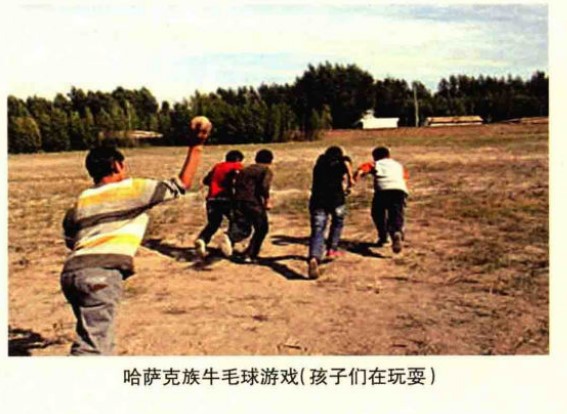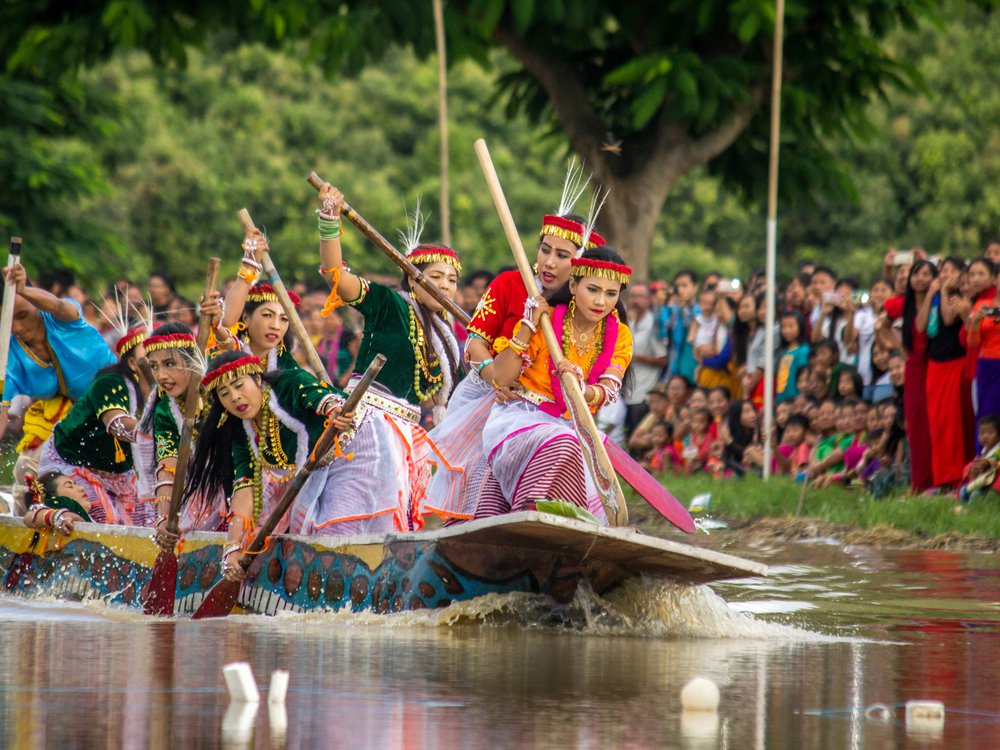- Name of sport (game): Hanoumantée
- Place of practice (continent, state, nation):
India
- Name of sport (game): Hapkido
- Place of practice (continent, state, nation):
Korea
- History:
The way of coordinated energy (internal). A Korean martial discipline that combines karate like moves (noted for its spectacular high kicks), judo throws and aikido circularity and joint manipulations combined with Ki (Chi) or internal energy. Hapkido was founded by Young Shui Choi in the late 1930's and early 1940's but was practiced under a variety of names up until the 1960's. Choi had previously studied daito ryu aiki jujitsu which he combined with his native hwarando and taekyon (a kicking art not to be confused with taekwondo).
- Name of sport (game): Hatching Egg Game
- Name in native language: 孵小鸡游戏
- Place of practice (continent, state, nation):
Xinjiang Uygur Autonomous Region, China
- History:
The origin of this game is unknown. It is popular among Kazak people especially Kazak children in Xinjiang, China. It is believed that Kazak people have invented this game during their grazing life. Now it is played by children of other minorities in China as well.
- Description:
This game needs a quick reaction and good dexterity. The aim of this game is to avoid being hit by a tennis ball or rubber ball thrown by other players.
You need a tennis ball/rubber ball (with a diameter of 5-6cm), some small pebbles or coins, some markers, sticks (if play outside), cardboard or wooden board (if play indoors). A court at least 8mx8m in size is needed. 5 to 6 players are preferable for this game.Detailed rules:
1. Six or seven holes are digged in a dirt surface which is 10cm in diameter and 5cm in depth each. Each hole is assigned a number corresponding with player’s number 1-6. If played indoors, you could cut holes on cardboard or wooden board and put number markers inside instead.
2. A starting line is drawn about 2-3 meters away from the closest hole.
3. Players draw lots to decide their number (or simply assign numbers to them).
4. All players stand behind the starting line. Player 1 starts the game by rolling or tossing a tennis ball to other player’s holes. He/She has three chances to roll and toss the ball. If he/she succeeds, the player who’s the ball lands in the corresponding hole (as an attacker) must pick up the ball instantly and tries to hit other players while other players (as dodgers) run away and try to avoid being hit. If the attacker succeeds in hitting the other player, the player who is hit gets a penalty point. If the attacker misses, the attacker receives a penalty point. A small coin or pebble (as an egg) will be put inside the penalized player’s hole (represented as a penalty point).
5. Now it is player 2’s turn to toss the tennis ball. The rules are same as step 4& step 5.
6. Everyone takes turns to roll/toss balls until someone gets 5 penalty points. Then he/she is out of the game and becomes a loser. The game is over. He/she will receive some humiliation from other players such as being patted by other players or imitating chicken sounds. Then the game starts over again. After several rounds, the player who gets the least penalty points wins. Variation:
A. If a player tosses or rolls the ball to his/her own hole, he/she will receive a penalty point.
B. If a player cannot roll or toss the ball inside a hole (except his/her own’s) within three chances, he/she will receive a penalty point.
C. Sometimes an additional hole is digged in this game (as the red hole in the following graph shows). It is acted as “an egg bomb”. If someone rolls the ball to the trap hole at any time during the game, he/she will lose this round of game instantly as the “egg bomb explodes”. So you need to be careful not to roll the ball to this trap hole.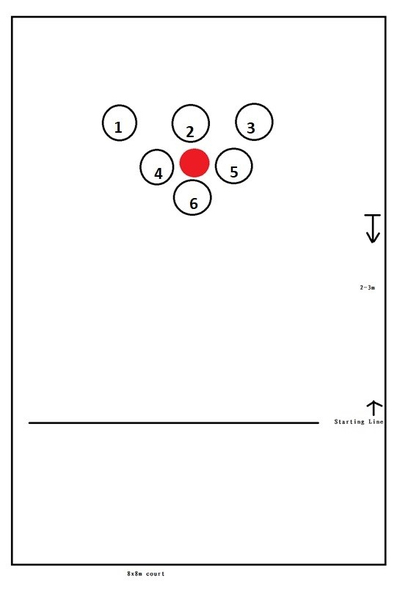
A similar game played in Greece called “lakkoudakia” (literally “puddles”)
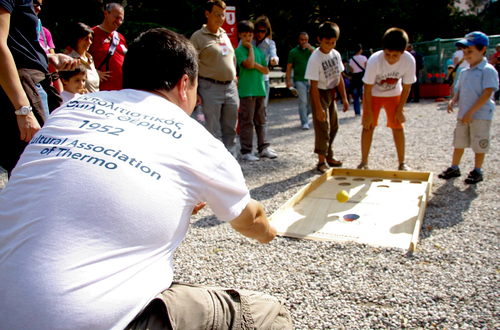
- Current status:
Practiced
- Importance (for practitioners, communities etc.):
This game improves aiming and motor skills.
- Name of sport (game): Hiyang Tannaba
- Place of practice (continent, state, nation):
Manipur, India
- History:
According to many, the beginning of this race dates back to Manipuri King Luwang Ningthou Punshiba. It is said that he is the one to have crafted the first boat in this ancient land. Two craftsmen, namely Wangmanao Sinmeiba and Nungban Wangmitkhu Khuteiba, used to work for him. Over the time the "hi" (canoe) slowly developed and took the form of "hiyang" (long boat). Legends are of the opinion that in the later period during the reign of King Hiyangloi Ningthou, it became a sport and a source of entertainment. The source of inspiration was a successful hunt which called for a boat race to celebrate his hunting expedition. This event led to the beginning of the sport which is still being practiced in Manipur.
Source: https://www.indianetzone.com/13/hiyang_tannaba.htm - Description:
The boat used in the game is called 'hee' while the oars are termed as 'nou'. Usually, only two boats take part in the contest. However, sometimes many beautifully decorated boats can also be seen participating in this game. The dimensions of the boat are variable. The boat can carry as many sailors as they want, the minimum being 20. The race starts with a ritualistic ceremony to Lord Sanamahi. Lord Sanamahi is the ruling deity of every Manipuri household who is worshipped for safety and protection.
Even the sailors are up for the festival by dressing up in nice traditional outfits. The teams have a Tengmai Leppa or captain who positions themselves at the bow of the boat. Judges too are appointed - one positions him at the starting line and the other at the finishing line. Supporters of both teams are present for encouragement. The supporters, who are the intrinsic part of the game, are known as hiban chenba or khongban chenba in Manipuri language.
Source: https://www.indianetzone.com/13/hiyang_tannaba.htm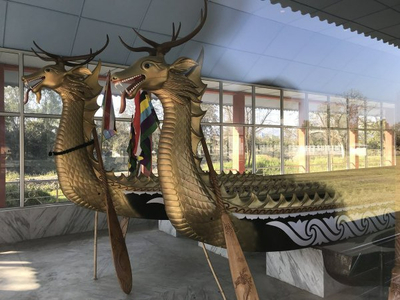
Source: https://www.quora.com/When-are-the-grand-dragon-boats-used-in-the-boat-racing-festival-Hiyang-Tannaba-in-Manipur - Current status:
Practiced
- Sources of information :
Articles:
https://www.indianetzone.com/13/hiyang_tannaba.htm
http://kanglaonline.com/2013/10/hiyang-tannaba/Video:
https://www.youtube.com/watch?v=2bYThNlf6KU
https://www.youtube.com/watch?v=XUFEYY5ZxY8
https://www.youtube.com/watch?v=8vro2KHlM9QSource of photos used in this article and gallery:
https://photocontest.smithsonianmag.com/photocontest/detail/hiyang-tannaba/
http://www.e-pao.net/epGallery.asp?id=30&src=Festival/HeikruThangapat20140905_4
https://bishnupur.nic.in/tourist-place/bishnupur/
https://www.quora.com/When-are-the-grand-dragon-boats-used-in-the-boat-racing-festival-Hiyang-Tannaba-in-Manipur
https://imphalwest.nic.in/
https://www.thebetterindia.com/91440/manipur-imphal-loktak-travel/
https://www.tlcworldtravel.com/inspiration/attractions-events/
https://www.prokerala.com/news/photos/imphal-traditional-boat-race-hiyang-hirel-tanaba-27485.html - Gallery:
- Documents:
- Name of sport (game): Hsing-i
- Place of practice (continent, state, nation):
China
- History:
Hsing-i came originally from the north of China (San Shih province) spreading to Hepei, then to Hunan and Peking. Weapons include the knife and sword. Hsing-i is a northern style that originated and spread elsewhere including Peking. A famous story recounts how the famous Hsing-i boxer Kua Yun-Shen challenged Tung Hai ch'uan, a famous pa qua teacher to a match. Pa Qua was known for it evasion and circularity of technique that lay in stark contrast to hsing-i's powerful linear style. The match lasted three days. During the first two neither could gain advantage. Both were equally matched. But on the third Tung defeated his challenger - the two ending up as friends and vowing to thereafter teach the two styles together. Thus, even today when you find one system the other is often taught along with it. Both are classified as internal disciplines that develop and utilize internal energy of Ki (chi in China). Both disciplines share the concept that the mind unites actions and thought into one, so that training the mind allows transformation of the internal to the external technique.
- Description:
Also spelled Hsing-yi. "Mind Form." A powerful ancient Chinese martial discipline based on Chinese Cosmology (five element theory) that stresses direct linear techniques combined with the use of internal energy (chi). Hsing-i moves use power and speed to confront power directly and overwhelm it. Hsing-i also employs several weapons including the knife and the sword. Its forms are drawn from observations of animals and their fighting methods. The system mimics concepts of animal fighting, along with postures based on the five elements. The animals in some systems include: the horse, tiger, monkey, swallow, snake, bear, leopard. cockerel, calercaille, dragon, hawk and water skimmer. Other systems substitute the dove, turtle, falcon, eagle and others. While the system visually resembles the hard styles of Chinese kung fu (that emphasize muscle power), its real emphasis is the development and control of internal energy (chi kung). "Hsing" meaning "form" and "i" meaning "idea," or "idea behind the external form" which includes not only physical movements but knowing the intention or ideas of the opponent (intuition). The emphasis on intuitive knowing is shared with Pa-qua (often taught with Hsing-i) whose more circular, non-direct and evasive actions complement hsing-i's the more linear technique.
- Name of sport (game): Huyen langlon
- Place of practice (continent, state, nation):
Manipur, India
- Name of sport (game): Hwarang-do
- Place of practice (continent, state, nation):
Korea
- History:
"Flower man way," or "The way of the flowering manhood." A broad based and complex Korean martial discipline that combines body movements with kicks, blocks and strikes, throws, joint manipulations, choking and submission techniques, ki training, weapons and the healing arts. The original art is said to have been created over 1800 years ago by a Buddhist priest, Won Kwang Bopsa. He was asked to instruct members of the royal family of Silla (one of three kingdoms that divided the area that is now Korea) in a variety of subjects, and his students went on to become warriors, statesmen and leaders known collectively as the hwarang. Later, during periods of political turmoil, training continued in secret within Buddhist monasteries and was preserved. In the modern era, two brothers, Joo Bang Lee and Joo Sang Lee, trained under the 57th successor of the system, the Buddhist monk Suahm Dosa, and they were given permission to teach publicly in 1960. Since then the art has spread under the direction of the World Hwarang-do Association.
- Sources of information :
Articles:

